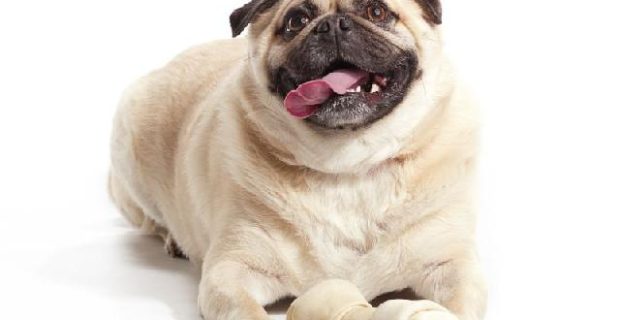Carolina Zaghi Cavalcante
A obesidade é definida como acúmulo excessivo de tecido adiposo no corpo, suficiente para prejudicar as funções fisiológicas do organismo. É o resultado de um desequilíbrio entre energia consumida e energia gasta, o que conduz a um persistente ganho calórico, sendo um importante fator de risco para o desenvolvimento de diversas doenças, como diabetes mellitus, danos osteoarticulares, afecções do trato respiratório, cardiovascular, urinário, neoplásicos e redução da qualidade de vida.
Estudos realizados há mais de uma década já mencionavam a obesidade como uma pandemia para pessoas e animais domésticos. No mundo, aproximadamente, 59% dos cães e 52% dos gatos estão sobrepesos e obesos, sendo as causas deste distúrbio consideradas complexas de origem social e multifatorial.
Dentro das prováveis origens da obesidade pode-se incluir predisposição genética, doenças endócrinas, castração precoce e alguns fatores exócrinos, como consumo excessivo de alimentos, composição da dieta, uso de medicamentos que levam a polifagia, ausência de atividade física, estilo de vida sedentário e fatores ambientais.
Inúmeros métodos são utilizados como forma de avaliação corporal para o diagnóstico de sobrepeso e obesidade. O método mais preciso e já padronizado é a técnica de densitometria de duplo feixe de raios X (DEXA). Contudo, outros métodos mais fáceis e acessíveis podem ser utilizados para a avaliação corporal, como a avaliação do peso corporal, a determinação do escore de condição corporal (ECC) e a estimativa da porcentagem de gordura corporal (%GC), obtida por meio de medidas morfométricas e estimativas de índice de gordura corporal.
Leia todas as considerações da profissional no artigo da edição de novembro da C&G VF.
Fonte: Redação Cães&Gatos VET FOOD.
Confira as referências bibliográficas utilizadas pela autora do artigo:
Buelund LE, Nielsen DH, Mcevoy FJ, Svalastoga EL, Bornvad CR. Measurement of body composition in cats using computed tomography and dual energy X-ray absorptiometry. Vet Radiol Ultrasound. 2011, v. 52, p.179-184.
Butterwick R. How fat is that cat? J Feline Med Surg. 2000; v.2, p.91-94.
Case, L. P.; Carey, D. P.; Hirakawa, D. A. Nutrição Canina e Felina. Editora Harcourt Brace. Espanha: Madrid, 1998.
Case, L. P.; Daristotle, L.; Hayek, M. G.; Raasch, M.F. Energy Balance. Canine and Feline Nutrition. A Resource for Companion Animal Professionals. 3a ed. Missouri: Editora Mosby Elsevier, 2011, p.59-74.
Corbee RJ. Obesity in show dogs. J. Anim. Physiol. Anim. Nutr. (Berl). 2012;97
Courcier E.A., Thompson R.M., Mellor D.J. An epidemiological study of environmental factors associated with canine obesity. J Small Anim Pract 2010;51:362-367
Gant P, Holden SL, Biourge V, German AJ. Can you estimate body composition in dogs from photographs? BMC Veterinary Research. 2016, v.12, p.1-12.
German, A. J.; Ryan, V. H.; German, A. C.; Wood, I. S.; Trayhurn, P. Obesity, its associated disorders and the role of inflammatory adipokines in companion animals. The Veterinary Journal, 2010, v. 185, p. 4-9.
German AJ, Holden SL, Wiseman-Orr, ML, et al. Quality of life is reduced in obese dogs but improves after successful weight loss. Vet J. 2012; v.192, p.428-434.
German, A.J. Obesity Prevention and Weight Maintenance After Loss. Veterinary Clinics of North America: Small Animal Practice. 2016, v. 46, p. 913-929.
Hamper B. Current topics in canine and feline obesity. Veterinary Clinics of North America: Small Animal Practice. 2016, v.46, p. 785-795.
Kronfeld, D.S.; Donoghue, S.; Glickman, L.T. Body condition and energy intakes of dogs in a referral teaching hospital. Journal of Nutrition. 1991, v.121, p. 157-158.
Laflamme, D.P. Development and validation of a body condition score system for dogs. Canine Practice. 1997, v.22, p. 10-15.
Larsen, A. J.; Villaverde, C. Scope of the Problem and Perception by Owners and Veterinarians. Veterinary Clinics of North America: Small Animal Practice. 2016, v. 46, p. 761-772.
Linder, D.; Parker, V.J. Dietary Aspects of Weight Management in Cats and Dogs. Veterinary Clinics of North America: Small Animal Practice. 2016, v. 46, p. 869-882.
Lund, E.M. et al. Prevalence and risk factors for obesity in adult dogs from private US veterinary practices. Journal of Applied Research in Veterinary Medicine veterinary. 2006, v.4, p.177-186.
Lund, E.M. et al. Prevalence and risk factors for obesity in adult Cats from private US veterinary practices. Journal of Applied Research in Veterinary Medicine veterinary .2005;3:88-96.
Mao, J. et al. Prevalence and risk factors for canine obesity surveyed in veterinary practices in Beijing, China. Preventive Veterinary Medicine, v. 112, n. 3–4, p. 438–442, 2013.
McGreevy P.D., Thomson P.C., Pride C., Fawcett A., Grassi T., Jones B. Prevalence of obesity in dogs examined by Australian veterinary practices and the risk factors involved. Vet. Rec. 2005;156:695–701.
Mlacnik, E. et al. Effects of caloric restriction and a moderate or intense physiotherapy program for treatment of lameness in overweight dogs with osteoarthritis. Journal of the American Veterinary Medical Association. 2006, v.120, n.229, p.1756-1760.
Siess, S et al. Why Psychology Matters in Veterinary Medicine. Top Companion Anim Med. 2015, v. 30, n.2, p.43-47.
Tvarijonaviciute, A.; Tecles, F.; Martínez-Subiela, S.; Ceron, J. J. Effect of wheight loss on inflammatory biomarkers in obese dogs. The Veterinary Journal. 2012, v. 193, p. 556-558.
Zoran, D.L. Obesity in Dogs and Cats: A Metabolic and Endocrine Disorder. Veterinary Clinics of North America: Small Animal Practice. 2010, v, 40, p. 221–239.
White, G.A. et al.,Who’s been a good dog?” – Owner perceptions and motivations for treat giving. Preventive Veterinary Medicine. 2016, v. 132, p.14–19.
White Ga, Hobson-West P, Cobb K, et al. Canine obesity: is there a difference between veterinarian and owner perception? J Small Anim Pract. 2011, v. 52, p.622–626.
Witzel, AL.; Kirk, CA.; Henry, GA., et al. Use of a novel morphometric method and body fat index system for estimation of body composition in overweight and obese dogs. Journal of the American Veterinary Medical Association. 2014, v. 244, n. 11.
WSAVA Global Nutrition Panel. Nutritional assessment guidelines. Available at: www.wsava.org/sites/.









